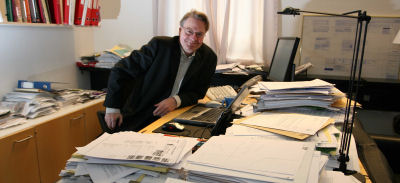Master in Computational and Applied Mathematics
Teacher Interviews
Frontline teaching design
Professor Lars Kai Hansen is head of both the Intelligent Signal Processing Group and the Intelligent Sound - framework program at IMM. He is also one of the key persons behind the modern course design at the department. Lars Kai explains his view points on teaching and tests:
"A major breakthrough at DTU came when we went from traditional lectures to hands on teaching. Earlier on teaching was mainly in the form of class lectures but five years ago we changed our approach completely. We initiated a new strategy and only 50 % of the teaching is now in the form of lectures. The remaining time the students are at the computers working with data extracted from industry or from research projects. The courses at IMM are now characterized by proximity to real life situations and by their very intensive student participation."
New evaluation methods
- Working with computers at the data bars has made the new teaching methods possible?
"As an example I would like to highlight signal processing the course which I am teaching. Every Thursday afternoon the students work at the data bars on specific problems and with experiments originating from real data. By analyzing existing data from the real world the students become easily motivated."
- What about the exams?
"We are trying to accomplish a strong correlation between the courses and the way we evaluate the same courses. In essence the evaluation is a strong mirror image of our teaching ambition and objectives. The expected student performance and the target skills of our candidates must be reflected in the course curricula. The fact that the exam is based on experiments done by the students at the data bars enables the students to make a direct comparison to a real engineer work situation. An engineer is often assigned a task with a certain amount of time available for the data assessment. After that time the engineer must present his analysis and conclusions to the company executives. Obviously by having exams simulating this situation we focus on the student ability to make a coherent vocal presentation of his results and test his argumentation skills. This is very much is in line with what an engineer is expected to do in a real job situation."
Data bars and posters
- To sum up the students acquire a practical and reality based experience from the courses?
"Before we made the changes in our teaching methods whole semesters went by without the students actually saying anything. Now the teachers and students are constantly talking and expressing viewpoints during the data bar sessions. This kind of teaching is only possible because DTU has very advanced data bars and we have a limited number of students in each class. No more than 20 to 40 students are present during the data bar sessions at IMM. Our lecturers encourage the students to explain what they are seeing and to explain the significance of their observations."
- So hands on education is a key factor. What about the student presentation skills. How is that taught?
"In the first part of the year our students attend a number of lectures. The remaining time is spent on a research project. The accompanying research experiments are hopefully of a quality which makes them suitable for poster presentation like those seen here on the department wall. Our students are trained to present their results in the same manner as researchers do at a scientific conference. From the start of the semester we ask the students to think in a visual manner. They are asked to design their experimental work with the purpose of producing interesting charts and diagrams. Very few students have ever tried something like that and the student response to this type of examination is extremely positive. During the courses our students gets the tools needed to transform the data into interesting results and to present these results both visually and vocally impressing."

Professor Lars Kai Hansen: "We seek to fit the evaluation closely to our teaching. The structure of the student tests are reflected in the way the students work throughout the course. The goal is a closely resemblance to a real engineer working situation."
Morten Nonboe Andersen, January 10, 2006.

